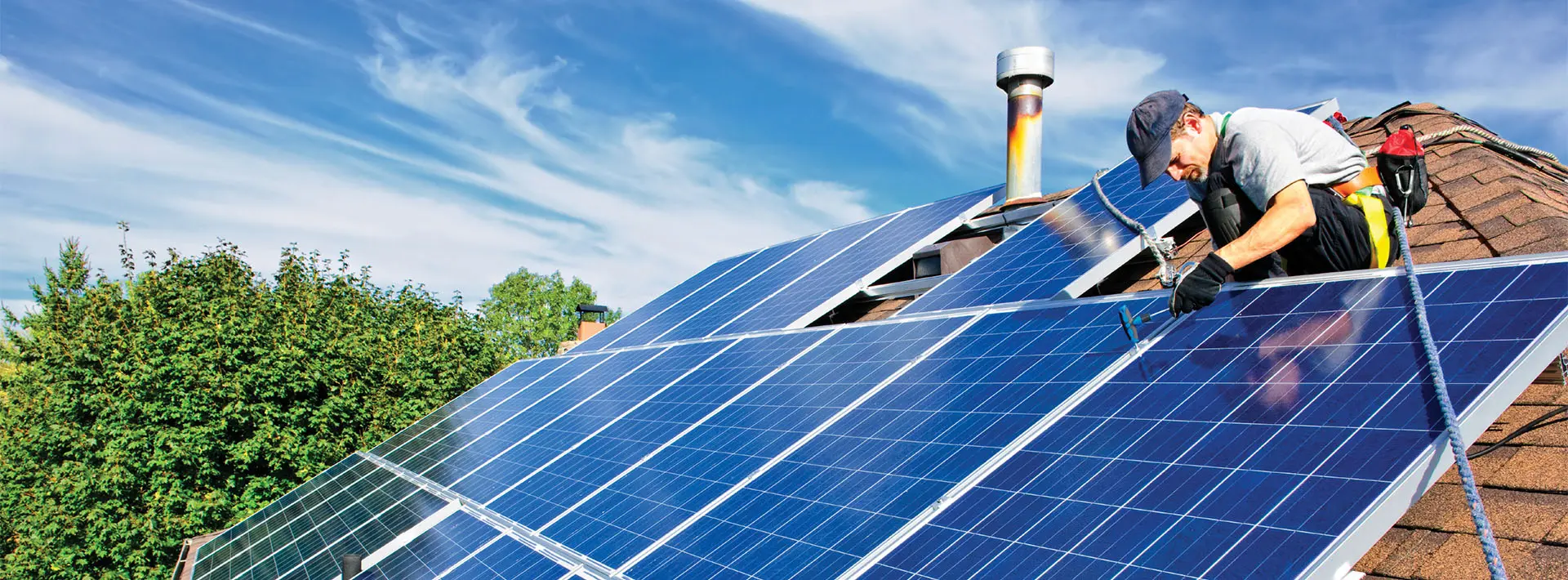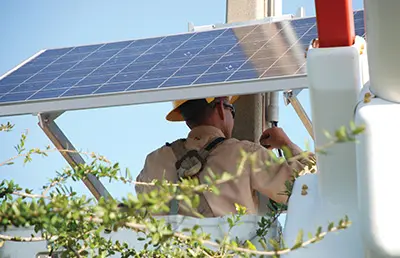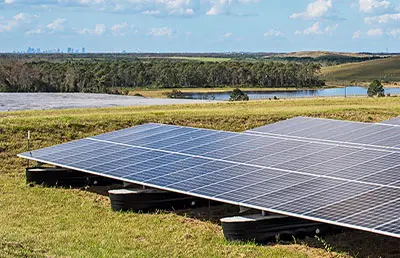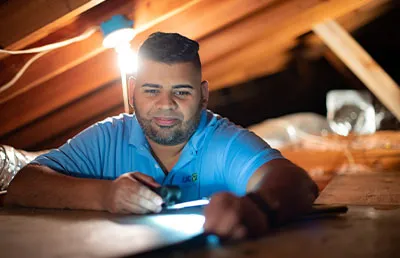How a Rooftop Solar System Works
Solar panels are usually rooftop-mounted and convert sunlight into usable power, sending any excess to the OUC power grid. When the solar system isn’t producing enough energy, such as on cloudy days or when the sun is not shining, the grid supplies the power unless a battery backup is in place.
Power is generated by converting solar energy into electricity, typically using photovoltaic (solar) panels.
The harnessed solar is used to power appliances and electrical devices in your home. Solar offsets some of the power you would have used from the grid.
Excess electricity that is generated by the solar system and not used by the customer is sent back to OUC’s electric grid.
Solar only powers your home when the sun is out. The grid powers your home at night.
Effective July 1, 2025, TruNet Solar will change how solar PV customers receive net metering credits for excess electricity generated.
How to Set Up a Rooftop Solar System
Step 1
Do your research.
Step 2
Choose a certified solar contractor and install.
Step 3
Interconnect with OUC.
Step 1
Use our resources to help you find out if you’re a good candidate for solar energy.
Calculate the kilowatt size of the rooftop PV system you would need. To do this, log into your myOUC account or request your consumption history from customer service.
Request a free OUC energy audit or call (407) 423-9018 to schedule an appointment. An audit is a great way to determine if there are opportunities for energy savings. By cutting back on your energy usage, you may reduce the size of PV system you would need for your home.
Step 2
Solicit quotes and select a contractor to install the solar system. OUC recommends getting at least four quotes. For assistance finding a solar contractor, consider visiting OUC Preferred Contractors.
Pull or have a contractor pull the required permits and install the solar system. All PV system installations must comply with OUC’s Interconnection Requirements.
Step 3
After the permit inspection is complete, have your contractor submit a solar interconnection application on your behalf through our online portal. Please see the Interconnect with OUC section below for details on how to submit an interconnection application.
OUC will then review the application, and if approved, exchange the existing electric meter for a bi-directional meter.
Interconnect with OUC
Effective July 1, 2025, all customers who submit a payment along with a completed solar interconnection application will be credited for energy exported to the grid at the community solar farm rate for a five-year period ending June 30, 2030, and at the retail fuel rate thereafter. Rate changes will not take effect until March 2026.
Contractors or Solar Installers
If an OUC customer has contracted your services for the installation of solar PV panels, please follow the steps below to ensure successful installation and interconnection:
- Contact Us: Email [email protected] the service address and proposed size system or one-line diagram for review of a transformer upgrade.
- Obtain Permits: Pull all necessary permits from the appropriate jurisdiction.
- Install the Solar System: All PV system installations must comply with OUC’s Interconnection Requirements.
- Permit Inspection: Complete final permit inspection with designated jurisdiction.
- Submit Interconnection Application: After the permit inspection is complete, submit an online interconnection application. Please see below for a list of required documentation.
Submitting an Interconnection Application
All interconnection applications and supporting documentation must be submitted via our online portal. For registration instructions, click here. Once registered, contractors will be able to submit their customers’ interconnection applications via the portal, as well as track application status.
Required Documentation
Make sure the following documents are submitted as part of the interconnection application.
- Passed City/County Permit Inspection or Certificate of Completion.
- Proof of purchase of the solar system. This invoice must include the customer’s name, service address, itemized cost and the customer’s signature. Please reflect the cost of the battery separate from the solar PV system, if applicable.
- An electrical one-line diagram. If the PV system is certified by a professional engineer, then the one-line diagram must be sealed and signed by a licensed professional engineer. Click here to view an example of an acceptable one-line diagram.
- Proof of insurance (only Tier 2 and Tier 3 applications)
- Proof of payment (only Tier 2 and Tier 3 applications)
OUC will review the application, and if approved, will reconfigure the meter. In rare cases, the customer’s existing electric meter may be exchanged for a bi-directional meter.
Residential & Business Customers
OUC recommends that you conduct an energy audit to ensure your home or business is as energy-efficient as possible before installing a solar system. Contact OUC’s Customer Service at (407) 423-9018 or fill out our online form to request an energy audit.
If you determine your site is a good candidate for solar energy, please follow this step-by-step process to ensure successful installation and interconnection.
- Solicit quotes and select a contractor to install the solar system. OUC recommends getting at least four quotes. For assistance finding a solar contractor, consider visiting OUC Preferred Contractors. Use of an OUC Preferred Contractor is not required.
- Pull or have a contractor pull the required permits and install the solar system. Please note, all PV system installations must comply with OUC’s Interconnection Requirements.
- After permit inspection is complete, have your contractor submit a solar interconnection application through our online portal.
- OUC will review the application, and if approved, will reconfigure the meter. In rare cases, the customer’s existing electric meter may be exchanged for a bi-directional meter.
Make sure the following documents are submitted as part of the interconnection application:
- Passed City/County Permit Inspection or Certificate of Completion.
- Proof of purchase of the solar system. This invoice must include the customer’s name, service address, itemized cost and the customer’s signature. Please reflect the cost of the battery separate from the solar PV system, if applicable.
- An electrical one-line diagram. If the PV system is certified by a professional engineer, then the one-line diagram must be sealed and signed by a licensed professional engineer. Click here to view an example of an acceptable one-line diagram.
- Proof of insurance (only Tier 2 and Tier 3 applications)
- Proof of payment (only Tier 2 and Tier 3 applications)
OUC’s Interconnection Requirements
Click here to download key documentation:
About TruNet Solar
TruNet Solar is OUC’s net metering program. Under this program, OUC will continue to pay the current incentive (full retail rate) to existing rooftop solar owners (including all customers with an approved rooftop solar interconnection application received by June 30, 2025) for a 20-year grandfather period.
Effective July 1, 2025, all customers who submit a payment along with a completed solar interconnection application will be credited for energy exported to the grid at the community solar farm rate for a five-year period ending June 30, 2030, and at the retail fuel rate thereafter. Customers will receive the full retail rate during a temporary grace period through March 2026. An optional battery storage rebate will also be offered.
For more information on OUC’s electric rates, click here.
ON OR BEFORE JUNE 30, 2025
| Completed/Paid Application Received by OUC | Effective Date of Rates | Applicable Kilowatt-hour (kWh) Credit Rate for Exported Energy* |
|---|---|---|
| June 30, 2025 | June 30, 2025 – June 30, 2045 | Full Retail Rate |
ON OR AFTER JULY 1, 2025
| Completed/Paid (if applicable) Application Received by OUC or Change in Account Holder | Effective Date of Rates | Applicable Kilowatt-hour (kWh) Credit Rate for Exported Energy* |
|---|---|---|
| July 1, 2025 or later | July 1, 2025 – March 2026 | Full Retail Rate during temporary grace period for all solar customers |
| July 1, 2025 or later | March 2026 – June 30, 2030 | Community Solar Energy Rate |
| July 1, 2025 or later | July 1, 2030 – June 30, 2045 | Retail Levelized Fuel Rate |
*Rates subject to change
Frequently Asked Questions – TruNet
What is Trunet?
TruNet Solar is OUC’s net metering program.
Effective July 1, 2025, all customers who begin a new solar interconnection agreement will be credited for energy exported to the grid at the community solar farm rate for up to a five-year period ending July 1, 2030. After this period, they will be credited at the retail fuel rate.
OUC will continue to credit existing rooftop solar owners (including all customers who submit rooftop solar interconnection requests by June 30, 2025) for a 20-year grandfather period ending June 30, 2045.
Why is OUC changing net metering?
TruNet is intended to “true up” the price of solar so net metering rates more accurately reflect the costs associated with maintaining grid infrastructure and storing and transmitting electricity.
I’m an existing rooftop solar customer. How long will I be grandfathered in with the current net metering rate?
The grandfathering period – which covers existing solar customers and those who submit a solar interconnection application by June 30, 2025 – lasts 20 years through June 30, 2045.
I’m currently billed under a grandfathered solar rate plan. If I add more solar panels, will I lose my grandfathered status?
An add-on solar PV system will not affect the grandfathered status of an account and will be billed under the same rate plan as the original installation.
Can I still apply to be grandfathered in at the existing solar retail rate?
Existing rooftop solar customers will be automatically grandfathered. New rooftop solar customers who submit a solar interconnection application by June 30, 2025, will be grandfathered, once approved, at the existing retail rate for a period of 20 years.
Please note that financing, permitting, and installing solar is a time-consuming process, and we recommend planning in advance to meet the upcoming deadline.
What if I want to sell or rent my home?
The Solar Interconnection Agreement remains on file for the premises in OUC’s billing system. If you sell or rent your home, the new owner or tenant will need to contact OUC to either establish a new OUC electric account or transfer an existing one to the new premises. Their compensation rate for excess energy will be based on the rate in effect on the date when the new or transferred account is activated.
if I move, will the new homeowner be grandfathered?
If you sell your home and the new homeowner takes possession and establishes an OUC electric account by June 30, 2025, the new homeowner will receive the full retail rate for excess energy sold to OUC through June 30, 2045.
If you sell your home on or after July 1, 2025, the new homeowner will receive the community solar energy rate for excess energy sold to OUC through June 30, 2030.
What if I move from one home with solar to another?
If you purchase a new home with existing solar, and take possession and establish or transfer an OUC electric account by June 30, 2025, you will receive the full retail rate for excess energy sold to OUC through June 30, 2045.
If you purchase a new home with existing solar, and take possession on or after July 1, 2025, you will receive the community solar energy rate for excess energy sold to OUC through June 30, 2030.
Our OUC bill is under my spouse’s name. Will the grandfathered rate pass to me should my spouse become incapacitated or pass away?
Yes, this will be treated in the same manner as transferring an account to the surviving spouse.
Are there any costs to apply for a solar interconnection?
Current fees are based on the array’s gross power rating, as measured in alternating current (AC), installed on a customer’s premises:
- Tier 1: 0 – 10 kW – No fee
- Tier 2: >10 kW – 100 kW – $340
- Tier 3: >100 kW – 2,000 kW (2 MW) – $1,300
Solar interconnection fees may be paid online through OUC’s credit card portal, Bill2Pay. Credit card payments are typically processed within five (5) business days. Below are applicable fees assessed for use of OUC’s credit card portal:
- $5 – Payments under $1,000
- $10 – Payments over $1,000
Payments by check may take up to two weeks for processing once received. A $25 fee will be assessed for payments returned due to insufficient funds.
What requirements does my rooftop system need to meet for approval?
Applications for solar or solar plus battery storage must be located at the residence identified in the application. The capacity of the system should not exceed the needed energy requirements for the home.
If I produce excess energy, will I receive bill credits and be allowed to use those to pay my OUC bill, including OUC water charges, City of Orlando charges for stormwater, as well as all applicable taxes?
Yes, a customer will be billed for energy consumed from OUC and credited on that month’s bill for energy exported/sold to the grid.
If I produce excess energy, will any “bill credits” be rolled over to the next month so I can use them?
Before Spring 2026
Yes, a customer will be billed for energy consumed from OUC and credited (as kWh) into the customer’s solar bank in that month’s bill for energy exported/sold to the grid.
After Spring 2026
No, a customer will be billed for energy consumed from OUC and credited on the current month’s bill for energy exported/sold to the grid.
If I produce excess energy, will OUC continue to true-up my account at the end of the year and send payment to me if I produce more energy than I consume?
Before March 2026
Yes, a customer will be billed for energy consumed from OUC and credited on that month’s bill for energy exported/sold to the grid. OUC will ‘true up’ the solar bank in December 2025 and issue a credit to the customer’s account for any balance remaining in the bank. That credit will remain until the credit is offset by monthly fees and customer consumption.
Customers may request payment from OUC of the credit in the form of a check if the annual true-up results in a credit balance. OUC may conduct a second true-up in March of 2026 to credit any balance remaining in the solar bank prior to implementing any TruNet billing changes.
After March 2026
OUC will remove the solar bank from the customer’s account and credit the customer for generation in the month in which the generated energy is received. No additional true-ups will be necessary going forward.
What are the requirements to submit a solar interconnection application?
Solar applications and supporting documentation must be submitted through OUC’s online rebate portal. Mailed or e-mailed applications will not be accepted.
Solar interconnection payments may be made online. To be eligible for the full retail rate, payment along with the completed solar interconnection application must be received by June 30, 2025.
Required Documents for Submission:
- Passed City/County Permit Inspection or Certificate of Completion
- Proof of Solar System Purchase (itemized invoice signed by customer)
- Electrical One-Line Diagram (must include the seal & signature of a licensed professional engineer)
- Proof of insurance (only Tier 2 and Tier 3 applications)
Download our step-by-step guide to submitting a solar interconnection application.
Frequently Asked Questions – Installation
How can I make my home/business more efficient before installing solar panels?
Making your home/business as efficient as possible before installing solar panels may allow you to purchase a smaller solar PV system and save on costs. A great place to start is by requesting a free energy audit.
I want to install a solar photovoltaic (PV) system. How much should I expect to save on my bill?
A 1 kW DC system in Orlando is expected to produce an average of 1,350 kWh a year. For example, the expected annual production for a 10 kW DC system is approximately 13,500 kWh or 1,125 kWh per month. The estimated annual savings would equal $2,025.
Source: National Renewable Energy Laboratory – PVWatts
| 1350 kWh x 10kW DC = | 13,500 kWh/year |
| 13,500 kWh / 12 months = | 1,125 kWh/month |
| 1,125 kWh * $0.15 (OUC rate) = | $168.75 monthly savings |
| Total annual savings | $2,025.00 |
What size solar PV system should I install to offset my usage and be net-zero?
First, you’ll need to know your total electric consumption for the past 12 billing cycles. This can be obtained on your billing statement(s). Once you know your annual consumption, you can use the formula below:
Total annual consumption (kWh) / 1,350 kWh produced per kW DC = Solar PV kW DC size required to be net-zero
For example, if your average monthly consumption is 1,500 kWh, your annual consumption is approximately 18,000 kWh. If you divide 18,000 kWh by 1,350 kWh produced per kW DC it equals 13.33 kW DC required to be net-zero.
How much do solar PV systems cost?
The average cost per watt can vary widely and that’s why we recommend obtaining multiple quotes from quality contractors. In most cases, the average cost will be approximately $3 – $6 per watt (W). For example, a 10,500 W DC (10.5 kW DC) system could range from approximately $31,500 – $63,000 before incentives. Tools like Google Project Sunroof illustrate the anticipated cost of buying, financing or leasing your solar panels and are great resources.
Are there rebates or incentives available for installing a solar PV system?
While we do not offer a rebate, you may qualify for tax incentives. Please visit the DSIRE website to see what incentives are available in your area.
Why is it required to involve OUC when installing a solar PV system?
OUC needs to be aware a solar photovoltaic system will be interconnected for the safety of our crew working in the area and to manage the impact of solar projects on our grid. Additionally, OUC will verify that the metering equipment is capable of supporting a photovoltaic system. By interconnecting your system, you can obtain the benefits of net metering.
How does net metering work?
- Sunlight hits solar panels and generates DC current.
- The inverter converts DC electricity to AC.
- The AC electricity is supplied to the building.
- Excess electricity flows into the grid.
- Electricity is drawn from the grid when the supply from solar panels is not sufficient.
If I already installed a solar system in my home/business, can I still participate in OUC’s Solar Programs?
Yes! Please see OUC’s interconnection requirements above to ensure you can participate.
I received permission to operate, what’s next?
Ensure with your solar contractor that your solar PV system is turned on and monitor your production daily to ensure your system is producing as you expected. If you have not accessed your solar production data, please contact your solar contractor to request access to obtain this data.
If I am an OUC water-only customer, can I participate in OUC’s Solar Programs?
No, participation in OUC’s solar programs requires customer’s electric service be provided by OUC.
Does OUC install the solar system?
No, OUC does not offer a program where we install solar PV systems for the customer. However, we have a list of solar contractors through our Preferred Contractor Network.
What types of permits are required?
The City of Orlando requires a building and electrical permit for PV and a building and plumbing permit for thermal. For more information, visit the City of Orlando permitting site.
- Orange County requires an electrical permit for PV and a plumbing permit for thermal. For more information, visit the Orange County permitting site.
- St. Cloud requires an electrical permit for PV and a plumbing permit for thermal. For more information, visit the St. Cloud permitting site.
- Osceola County requires a building and electrical permit for PV and a building and plumbing permit for thermal. For more information, visit the Osceola County permitting site.
What type of meter does a solar PV system need?
The existing electric meter will be replaced with a bi-directional meter for net metering or reconfigured for net metering.
Frequently Asked Questions – Billing
Solar PV systems can present savings opportunities, but bad actors have cost Florida consumers thousands of dollars. Be sure to review Scams at a Glance: The Dark Side of Solar from the Office of the Attorney General for tips on how to avoid scams. (Versión en español)
Where can I find information on understanding my solar bill?
Explanations about each section of your solar bill can be found on OUC’s Understanding My Bill page.
Why does my solar array’s production in my app not match the Customer-Supplied kWh on my bill?
These are not the same. The Customer-Supplied Electric in kWh is the excess solar energy that was not consumed in the home or business. For example, if the solar panels produced 1,000 kWh but the Customer-Supplied Electric was only 400 kWh, this means that 600 kWh of the solar energy was consumed in the home or business.
Excess energy from your solar panels that is not used in your home or business goes back to the electrical grid. Please note that the production dates in your app are usually from the start of the month to the end, whereas your billing cycle dates are likely different and may not align.
The app from my solar company shows that my system is producing. Why am I not receiving a credit?
A credit is earned only when the Customer-Supplied kWh is greater than the OUC-supplied kWh. This means that after you’ve consumed some/all of your production in your home/business, the excess amount sent to OUC was greater than the amount we provided from the electric grid (OUC-Supplied Electric in kWh).
I was promised that I’d never pay another electric bill. What’s going on?
Each month, you are billed our electric Customer Charge, at minimum, along with your consumption. If your Customer-Supplied Electric in kWh is less than the OUC-Supplied Electric in kWh, you will be billed for the difference between those amounts. In addition, you will still receive charges for other services such as water, wastewater, solid waste, etc., depending on your location as well as taxes.
I made certain that I installed enough solar panels to be net-zero. Why am I still consuming energy from the electrical grid?
Net-zero is when your annual solar production equals your annual consumption. In order for this to happen, the right number of panels have to be installed. Even then, there are months (like the summer) when the production won’t cover your consumption. For example, if your annual solar production is 9,600 kWh and annual consumption is 9,600 kWh, you would be considered net-zero for the year. However, during the summer months (June through October), your consumption may be higher than your solar production.

What can I do if the company that installed my solar panels has gone out of business?
- Contact Local Solar Companies or Electricians: Reach out to other local solar companies or electricians who might be able to take over the maintenance and repair of your system. Some companies specialize in solar maintenance and repairs.
- Check for Acquisitions or Transfers: Find out if the company was acquired by another business or if your account was transferred to another provider. This information can sometimes be found in any communications you received from the original company.
- Contact the Equipment Manufacturer: The manufacturer of your solar panels or inverters might have a network of certified installers and service providers who can help you. They can also provide support for any warranty claims.
- Reach Out to Your Financing Company: If you financed your solar panels, your financing company might have resources or recommendations for service providers who can assist you.
- Check for Third-Party Warranties: If you have a third-party warranty or an Operations and Maintenance (O&M) package, contact the provider to see if they can help with repairs or maintenance.
- State Consumer Protection Agency: Check with the Florida Department of Agriculture and Consumer Services (FDACS) and the Florida Attorney General’s Office for any additional resources or advice they might offer.
Ways to Save with Solar
Not only will you cut your electric bill, but you can take advantage of special incentives for installing a rooftop solar system.
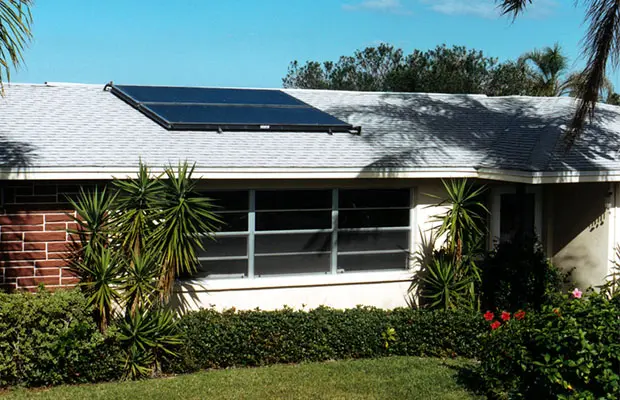
Solar Thermal Water Heater Rebate
OUC offers residential electric customers a rebate of up to $900 to install solar thermal systems. The average system takes up just 40 square feet of roof space and can reduce water heating consumption by 50% to 85%.

Federal Tax Credits
There is a 30% tax credit for the purchase and installation of solar electric and solar water heating systems through 2032.
External Resources

Google Project Sunroof
Input your address and get a customized solar savings estimate.

Department of Energy
Homeowner’s guide to going solar.

FSEC Research Center
Solar technology information from the University of Central Florida.

NREL PVWatts Calculator
Estimate the energy production of grid-connected solar systems.

